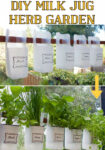Imagine it. Organized planters boxes laid out in a perfect pattern with walkways. Gardens that are bursting with life and look exceptionally manicured. Maybe you have seen them on t.v. and in magazines. These gardens that look as though they have been sculpted by a landscape artist. Have you ever wondered how it’s done or what it’s called? Well my friend, these gardens have a name, and it’s called square foot gardening. Looks difficult right? Maybe time consuming and too out of the box, well in this case in the box. In all actuality, this method is quite simple to undertake.
This simple method of gardening, has resurfaced over the years, and has become the next new gardening trend that everyone is digging into. From homesteads to the backyards of suburban neighborhoods and city community gardens, square foot gardening has helped many people turn the hobby of gardening into a fruitful lifestyle. Below, we have put together the ultimate guide for square foot gardening so that you can learn more about what it is and isn’t, its history, how you can get started and more.
What is Square Foot Gardening

When first looking at this gardening method, one might think that it would be difficult to achieve. However, that is not the case. There are two key words that are used when it comes to square foot gardening, planning and measuring. With careful planning and measuring, square foot gardening, or any method of gardening for that matter, is easy to do.
So what exactly is square foot gardening? Well, as its name indicates, it is a method that requires measuring space out for plants by the square foot. Square foot gardening is usually done in 4ft x 4ft planter boxes, or squares laid out on the ground. In this guide, we will refer to planter boxes for square foot gardening rather than just flat planting squares on the ground.

Photo: Robert Flickr
As of recent, this method has also been referred to as “raised bed gardening”. However, in raised bed gardening there is no grid system and measuring like there is in square foot gardening. The reason why this method is so popular, is because you can grow more food in less space. With the correct spacing and companion planting, square foot gardening allows someone to achieve high yields like those in traditional row gardening without using up a lot of space.
Square Foot Gardening History

Coined by American author Mel Bartholomew, square foot gardening, also known as SFG, was a method of gardening he invented in the late 70s. He later went on to write books about the subject, and became the founder of the Square Foot Gardening Foundation. He noted the practice as being ideal for residential areas, seeing as how they don’t often have a lot of space for gardeing.
It all began when Mr. Bartholomew retired in 1975 from his career as an efficiency expert and civil engineer. He was looking for a hobby and wanted to fill his time with something worthwhile, so he decided to join his local community garden as a hobby. With knowledge from his previous career, Mr. Bartholomew quickly realized there had to be a better way to create a garden. He was not content being told that in-ground row gardening was just the way to do it, because that’s how its always been done.
In 1976, with a year of gardening under his belt, Mr. Bartholomew invented square foot gardening. He wrote his first book on SFG in 1981, which then led to a popular tv series where square foot gardening ultimately became a household name. He went on to write more books, as well as institute a school program for students in Utah and California. In 1996 Mr. Bartholomew founded the Square Foot Gardening Foundation. His personal mission of solving world hunger continues today through the foundation, his legacy which he left behind upon his passing in 2016.
Planning: Location and Spacing

Location
Before building your planter boxes, filling them with dirt and laying out your grid, it’s best to first pick out the location for your square foot garden. There are several things to consider when picking out your SFG location, and they are:
- – The location should receive 6 to 8 hours of sun
- – Do not place by trees, as they may cause shade and their roots may interfere
- – Place it close to a water source
- – If using existing soil, be sure it is healthy
- – The area should drain properly
- – Watch for frost pockets
- – Make sure you have enough space for boxes(4ft x 4ft) and walkways(3ft wide)
Choosing location will be the time when you take your idea from paper to dirt. Counting out how many boxes along with walkways, marking water sources, checking and watching the area for a couple of days will all be needed in finding a location. This is where the careful planning begins for this gardening method. Be patient, all the work you put in will pay off.
Spacing
With your location chosen, spacing will be the next task at hand. As you were searching out your location you most likely started counting out how many planters boxes you could have in the area. Planter boxes can be 4ft x 4ft, 4ft x 8ft or 4ft x 12ft. The most common size of box utilized for this method is the 4ft x 4ft. Between each box you will need to account for about 3 feet of walking space.
It’s best to use stakes and string to help measure and mark off where everything will be. As mentioned above, measuring is the key to a successful SFG. Trust me, it will help you when you reach the building part. Also, as you are prepping your area, do not walk on your growing soil, especially if you are building bottomless boxes and mixing up your own soil.
Getting to Work: Building the Boxes

Building planters boxes can be done two ways, you can have a plywood bottom if doing a table top SFG on a hard surface, or a bottomless box if your garden is on the ground. A bottomless box essentially means you will either use the soil in the bottom, and there will not be a weed barrier. Now, as we have already stated, boxes are generally 4ft x 4ft. The depth of your box should be able to hold 8 to 12 inches of soil. The frame can be made out of wood, metal or plastic.
With your frames built, you will want to line them with a weed barrier if you are not using the soil from the ground. If filling with a store bought soil mixture, the barrier will help to reduce and eliminate weeds from growing in your boxes and competing with your plants. The soil mixture you put in your box should have equal parts vermiculite, peat moss and compost. You can easily find raised bed soil at your local home improvement store if you are not mixing your own.
Once each box is filled, it is time to lay out your grid on top of your planter box. A grid can be made out of wood slats or string stapled to the edges of your frame. You can also purchase grids online through various retailers, or at your local landscaping supply store. Your grid squares should measure one foot by one foot. The utilization of the grid is what makes square foot gardening stand out among other gardening methods. The grid is what will help you plant in a pattern.
Planting Process

As you might have noticed, this method of gardening requires quite a bit of measuring. From planning to building and planting, measuring is an integral part of each stage. With your grid in place, you are now ready for planting. But wait, how many seeds go in each square? And how should they be spaced? The answer to those questions is based off of the type of vegetable you are growing. Below, we have listed out the general number of seeds or plants along with their spacing requirements for SGF.
One Per Square Plantings

One per square, one hole in the center for one seed or one plant.
- – Tomatoes(staked)
- – Sweet potatoes
- – Rosemary
- – Potatoes
- – Peppers
- – Parsley
- – Oregano
- – Okra
- – Lettuce(head)
- – Kale
- – Eggplant
- – Corn
- – Celery
Two Per Square Plantings

The below can be planted side by side inside one square, given there is room for a support trellis.
- – Cantaloupe
- – Winter Squash
- – Cucumbers
- – Pumpkins
- – Watermelons
Up to Four Per Square Plantings

These will be planted in the four corners of the grid square. If you would like to grow less, simply plant less. These do not have to be 4 per square.
- – Tomatoes(caged)
- – Zucchini(caged)
- – Swiss chard
- – Summer Squash(caged)
- – Rutabaga
- – Winter radishes
- – Onions(for growing large bulbs)
- – Lettuce(leaf)
- – Leeks(for growing larger plants)
- – Kohlrabi
- – Garlic(for growing larger bulbs)
- – Basil
Eight to Nine Per Square Plantings

Plant these on the edges and center of the grid square. For example, 3 to the left, 3 in the center and 3 on the right. Just like those above, do not feel like you need to plant as many.
- – Green beans(bush or pole)
- – Turnips
- – Tomatoes(with no supports)
- – Spinach
- – Peas
- – Onions(smaller but more plants)
- – Garlic(harvest more smaller bulbs, but more plants)
- – Leeks(smaller but more plants)
- – Beets
- – Cilantro
Up to Sixteen Per Square Plantings

These will be planted in a pattern within the square just like the above. Just be sure they are of equal distance. If you do not plan to thin out the garden often, only plant 8 to 9 of the below.
- – Carrots
- – Parsnips
- – Radishes
In regards to broccoli, brussels sprouts, cabbage and cauliflower, these plants will need a lot of room for growing. These will need to be planted two plants for every four squares. As for artichokes, asparagus and rhubarb, these vegetables are not suited for growing in an SFG because the foliage of these plants overshadow other vegetables.
What is Companion Planting?

Square foot gardening utilizes a term called companion planting. This gardening technique takes into account what plants are mutually beneficial to one another. By inter-planting different species, you can benefit from the pairs ability to resist insects or prevent disease.
When companion planting, you will utilize the keywords planning and measuring yet again. The chart from the Almanac website in the link above will help you to know the type of plants that you can plant together. As you choose and pair, plan their grid spacing before planting to make sure you have the room they will need to grow. Making a mockup on paper is great way to getting your arrangement ideas down before rolling up your sleeves and getting your hands dirty.
Companion Planting Tips
The following tips, in addition with the grid planting guidelines noted above, you will be successful in planting your square foot garden.
Before planting, research the plants that should and should not go together. Knowing this information will help you greatly in the end. Mind their position to the sun and what each plant needs specifically to grow.
Keep plant heights in mind. When mixing tall plants with plants that are shorter, make sure the shorter ones love shade. By utilizing one plant to help another you will achieve the companion planting technique.
Border your square with insect repelling plants such as garlic, onions, herbs or flowers. By planting certain herbs and flowers like marigolds, you can naturally repel certain insects.
Pros and Cons of Square Foot Gardening

With any gardening method there will be pros and cons. Square foot gardening does have a dirty downside, but the cons are easily remedied.
Big Harvest
You have planned and planted. As your little plants grow and produce, you’ll notice high yields. Due to the intensive planting, you are going to harvest more. Although this is a pro, it can easily become a con if you do not have a plan in place for all the veggies you will be gifted from your hard work. Be ready to prep, freeze or can your way into fall. This type of garden is ideal for a large family who can consume the food regularly.
Quick Set Up
Yes and no. Depending on the space you have and careful planning you put into it, an SFG can be set up pretty fast. With premade grids and raised bed soil that can be purchased at your local home improvement store, beginners can get started quickly. Also, planters boxes can be placed just about anywhere, even over pavement. Ultimately, when compared to traditional in-ground row gardening, square foot gardening definitely requires less time and effort.
Maintenance
Maintenance is minimal with SFG. Each box is easy to access, thin and harvest. With the addition of weed barrier, weeds are nonexistent. With just a few minutes a day, you can maintain and keep up with a square foot garden. Although, if you have several planters boxes, you will be investing a bit of time watering, maintaining, and harvesting.
Weeding
As noted in the previous paragraph, square foot gardens involve less weeding. If you build a square foot garden with a weed barrier and you are using a pre-bought soil mix, there will be less weeds to pick. Tip: Instead of weed barrier on top of pre-existing soil, you can place cardboard. The cardboard will slowly break down, allowing the plant’s roots to extend into the soil while keeping weeds at bay. Weeds will grow however on the outside of boxes, and need to be kept in check. Keep in mind that overtime, seeds will blow into the beds and need to be pulled.
The Cost
The expense to start this method of gardening can be expensive, but all subsequent seasons will only cost you a little bit of soil, seeds and plants. As long as the soil is properly amended, it will not be stripped of nutrients. When beds are not in use, they can be covered with straw or mulch to prevent erosion. If you happen to have good soil already and are composting, then you can eliminate the need to buy soil each season.
Size and Depth
Smaller is better, but not always. Depending on what you like to eat will determine if SFG is right for you. Square foot gardens aren’t ideal for crops that take up a lot of room. However, with companion planning and a researched approach, you can grow just about anything in an SFG. Vegetables like vining winter squash, asparagus or corn will not work well, and may need a small plot in the ground beside the square foot garden if room permits.
As for depth, 6 inches of soil is not enough. A 6 inch depth is too shallow, and does not allow for proper root establishment. This is especially true if there is a weed barrier or a bottom to the planters box. Tip: If you’re square foot garden is atop pavement, be sure to build your frame at least 12 inches deep.
Watering
Here’s the dirt. You are going to need to water your square foot garden regularly. Soil in an SFG will dry out faster, especially if they have bottoms. You will find yourself watering often, and at some point may question what you were thinking starting an SFG. But, with a schedule and a water source close at hand, watering can be easier. Tip: Consider installing soaker hoses or a drip irrigation system. Another way to retain moisture, cover the surface of the soil with mulch.
Overall, square foot gardening is a solid method for beginners to jump into the hobby. From a home gardener to an old pro, an SFG will be your best friend if you are looking to really utilize a small area for gardening. Although it may have a few drawbacks, they are easily remedied. We hope this guide has helped you gain a better understanding of what square foot gardening is and how to get started. With careful planning and a bit of measuring, anyone can get this type of garden off the ground in no time, literally. Go for it, we’re rooting for you!
















